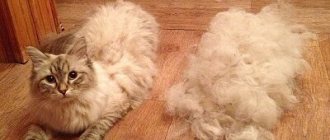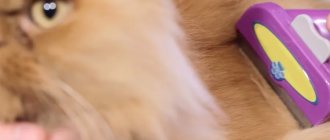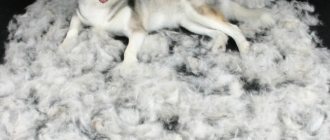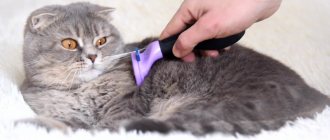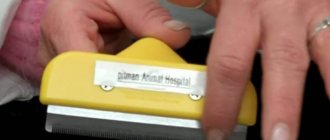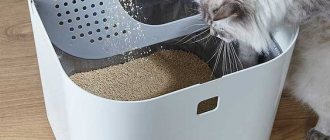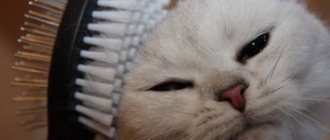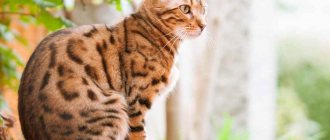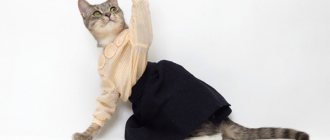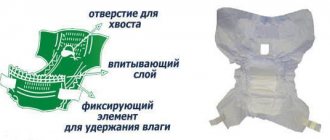The Furminator for cats is loved by many owners of mustachioed and tabby cats. Every owner wants to get rid of annoying animal hair in their apartment. It can cause allergies in humans, and intestinal disorders in cats if it enters the body. The problem becomes even greater if several pets live in the house.
In this situation, a furminator comb becomes a real salvation. Using the device, you can remove almost all fallen hairs from your pet’s undercoat and prevent them from spreading throughout the house.
What it looks like and how it works
Furminator is a tool designed for manual combing of wool. The device combines four functions:
- trimmer;
- comb;
- trimming knife;
- slicker
Cats have slightly thicker fur than other pets. This is explained by the fact that from each follicle, in addition to the central axis, two or three additional downy hairs grow, forming an undercoat of varying degrees of density.
If you did not completely cut your pet’s hair with a clipper, but decided to maintain the length of its fur, then the furminator will become the main tool for grooming the hair.
During molting, additional hairs die off, and new ones grow in their place. These excess hairs must be removed. Otherwise, they will constantly crumble, provoke the formation of tangles, and the cat will look untidy.
Warning! Classic combs cannot remove dead undercoat. Puffer brushes cope with it, but if used ineptly, they cause injury to the skin.
Furminator - developed by professional groomers. Outwardly, it looks like a men's razor, but the blade is replaced with a comb. The principle of operation is very simple - during operation, only dead hairs of the undercoat are removed. They hook onto the serrations covering the teeth and are pulled out. In this case, the guard hair slips between the denticles and remains intact.
Benefits of use
The Furminator is a comb-trimmer with a handle and a sharpened comb-shaped blade. There is a certain distance between the teeth of the comb. The Furminator works on the principle of a rake - it gently lifts the fur and removes it without sharp pulling or cutting. It removes dead hairs and undercoat without touching the outer coat - it slips between the teeth. This useful device makes the combing procedure less traumatic and stressful for the cat. Some animals even enjoy it, and owners prefer it to going to the salon.
How is a furminator better than a regular comb:
- the cat swallows less hair when licking;
- you can remove hair from sensitive areas of the body - the stomach, genitals;
- Combing is combined with massage, which is beneficial for blood circulation.
It is believed that using a furminator you can remove approximately 90% of dead hair. Thorough brushing will help reduce the time it takes for hair to become everywhere in the house by half during shedding.
Varieties
There are a lot of furminator models. They may differ in the set of attached devices and functionality. But the main difference is whether they are intended for brushing which cats – long-haired or short-haired.
How often do you need cat ear care, and what lotions, drops and other products are used at home?
For longhaired
Long hair most often has a soft and thin undercoat. Dead hairs fall off very quickly, become confused with the guard hairs and form unsightly tangles. The lumps are almost impossible to comb out, so they need to be cut out using a special tool - a tangle cutter. Because of this, the cat loses the appearance characteristic of its breed.
The appearance of a cat after brushing with a furminator
Furminators designed for combing long hair have:
- long teeth that easily reach the problem area (undercoat) do not cause injury to the skin and healthy guard hairs;
- The teeth are spaced far apart - this also helps keep the guard hairs intact.
The models offered by manufacturers take into account not only the age, but also the size of the pet. For example, you can buy a device not only designed specifically for an adult Nibelung, Ragamuffin, Ragdoll or British Chinchilla, but also for a kitten of the same breed. The necessary information can be read in the attached instructions.
Furminator models for long hair are labeled Large and are offered in two modifications. The first is used for combing cats with hair length up to 10 cm and weight up to 10 kg. The second is used when the size of the guard hair exceeds 12.5 cm.
For shorthaired
Shedding in these cat breeds comes with its own problems. Their hair is short and coarse. It is very difficult to clean and gets stuck everywhere it can: in clothes, carpet, upholstery.
Furminators for short-haired pets have short and frequent comb-trimmer teeth. Manufacturers offer models for all types of wool: hard, with virtually no undercoat, and densely padded.
The models also take into account the age and size of the cat. Available in Small, X-Small and Medium versions. The first is recommended for pets whose weight does not reach 5 kg, and the length of the guard hair is 4.5 cm. The second is used for combing kittens and small adult cats with 3.3 cm of hair. The third has teeth 6.7 cm long and is designed for pet weighing up to 10 kg.
The devices are offered in the Classic and Deluxe categories. They differ in external design and the material used for the handles. Deluxe models have an injector button. It allows you to remove hair from the comb automatically.
Well suited for cats from the Bobtail breed group. Owners, as a rule, are happy to use the Furminator for breeds such as the Karelian and Kuril Bobtail, American and Mekong Bobtail, and Pixie Bob.
For combing hair separately from the undercoat
There are no separate models for combing out the fur and the undercoat. All furminators presented on the pet products market combine both functions, i.e. Both shedding hair and dead undercoat hairs are removed.
How to properly comb a cat
Combing rules
Each type of wool is combed in its own way, choosing the most suitable tools for this.
But there are a number of rules that all cat owners must follow.
- Start the procedure when the animal is completely relaxed.
- Be patient. Not all pets approve of this procedure. A kitten can be distracted with a toy, but an adult cat needs to be rewarded as often as possible when it behaves well.
- Movements should be slow, gentle, along the entire length of the animal's body.
- First, movements are made along the hair growth, then against the hair growth. This helps to collect as much as possible all the dead fibers.
- During the combing process, frequently clean the tool (comb, brush, mitten) from accumulated hair.
- Particular care should be taken to comb those areas that the cat cannot reach on its own: ears, withers.
- The procedure always begins with tools with fine teeth, moving on to combs with more frequent teeth.
- To completely remove dead hairs, at the end of combing, run a soft chamois or a wet hand over the animal’s coat. This will add shine to the coat.
Important!
If there is more than one cat in the house, each pet should have its own grooming tools.
Video - rules for combing cats:
How to comb a short-haired cat
For cats of short-haired breeds, you will need a comb or comb with short teeth and a rubber massage brush (mitten).
- You need to comb in the direction of hair growth from the nape to the tail. The tail is combed last.
- After this, carefully comb the sides of the cat with a comb, slowly moving towards the stomach. If the animal doesn’t mind, comb the fur on its belly.
- Listen to your cat - if she allows you, brush her against the grain.
- Complete the procedure with a massage rubber brush (mitten). Wet it first to remove all dead hair.
- At the very end, you can polish the fur with suede or run it with a damp hand to finally clean the fur coat of fallen lint.
How to brush a long-haired cat
Grooming long-haired beauties will require more tools. This is a comb or comb with wide teeth, a brush with metal teeth, a comb with rotating teeth, a slicker (slicker), a tangle cutter, a furminator, a rubber brush (mitten).
- Begin brushing with a wide-tooth comb to straighten the fur.
- After this, comb with a brush or comb with rotating teeth from head to tail. Movements should be careful but strong. You need to move in the direction of fur growth.
- Next, move on to the armpits and stomach - there are longer strands of hair there. Gently comb out tangles and tangles. To work with tangles, use a tangle cutter.
- Finally, stroke the cat in the direction of hair growth with a rubber massage brush or mitten dipped in water. This will clean your pet's fur coat of all fallen hairs and give it shine.
Important!
During grooming, constantly clean the brush and comb of hair.
How to accustom a cat to grooming
There are several simple rules:
- Start training a kitten or an adult animal as early as possible - from the first days the pet appears in your home.
- Choose the right moment - the animal should be relaxed, calm and in a good mood.
- Do not approach a cat that has just eaten or woken up with a comb - this is not the best time for grooming. It is better to comb the animal before feeding; after the procedure, you can offer your pet his favorite treat.
- Place the cat in a comfortable place - it is good to comb it on the windowsill, it is light there, the animal is limited in its movements. And you won't have to bend over.
- Pet your pet and talk to it affectionately. Let him understand that you mean no harm.
- Let the animal smell and examine the grooming tool - the pet must understand that this is not a dangerous object and get used to it.
- Be careful but consistent. During the training period, carry out the procedure at the same time every day - the animal should get used to this procedure.
- Never force a cat or hold it by force - this will scare the animal and cause a negative reaction.
- Start grooming in places that cats love to be touched: neck, behind the ears, cheeks, chin. Only then carefully move to other places.
- Movements should be smooth, not too strong, and careful.
- It is best to start training with a massage mitten - most animals are loyal to them. When your pet gets used to it, move on to other tools.
- Upon completion of the procedure, each time gently praise the cat and give it its favorite treat - the pet will associate combing with pleasant things.
Important!
Never scold or yell at your cat if she resists and avoids the brush. You cannot forcefully comb your cat!
At what age should a cat be taught to groom itself?
Kittens are trained from childhood so that they become accustomed to the grooming procedure. They do this in a playful way. The best time for training is 5-7 months. At this age, cats go through their first molt.
Peculiarities
Devices have their own characteristics that need to be taken into account when purchasing. In particular, this applies to the breed of cat.
For Scottish Fold
Caring for cats of this breed is not at all difficult. Scots are much easier to comb due to the fact that their hair goes in both directions. That is why the pet can be stroked in any direction - both with the growth of the fur and against it.
You need to comb your Scottish Fold cat with a furminator with a sparse comb, pointing your hand from the tail to the head. Then the direction will need to be changed. At the end of the procedure, comb the coat with a brush with natural bristles to give it the desired smoothness and beautiful shine.
For British Shorthair
The British Shorthair also has its own Furminator model.
The width of the device brush depends on the size and weight:
- For kittens. You need to choose a comb 3 cm wide. The weight of the pet is no more than three kilograms;
- Small cats. Width – 4.5 cm. Weight – 3…10 kg;
- Big cats. Crest width – 6.5 m. Weight up to 10 kg.
For your information! Most often, British owners buy Furminators with large combs, because shedding and hair loss begins already in an adult pet.
For Abyssinian
For Abyssinian cats, 4 cm wide combs are suitable. They sink deeply into the coat and carefully remove all dead hair. But at the same time they do not injure the skin.
What is it - a furminator for cats
This invention was invented by a group of American specialists consisting of groomers, breeders and veterinarians. The device is not many years old, but it has managed to enter the lives of cat owners as a necessary item in their grooming arsenal.
The furminator looks like a comb with a handle. The main role here is given to the metal blade, which has an unusual sharpening. It allows you to capture hairs from the very depths of the undercoat and thereby remove almost all lost hair. The device body is made of durable plastic. The holder has an anti-slip rubber cover or rubberized inserts.
Undoubted advantages
When buying a furminator for cats, you need to understand what it is and how it differs from other accessories and combs. This will help you make the right choice. Compared to a slicker comb, the Furminator has several advantages in the fight against hair loss.
So, why do you need a furminator for cats with such a variety of grooming accessories:
- It removes dead inner undercoat. Conventional combs remove only the top layers and do not reach the undercoat, which can accumulate for a long time, becoming entangled in the long pile. The Furminator helps remove the hard-to-reach inner layer that can be so difficult to comb out.
- Does not spoil the structure of the coat. Despite the metal teeth, the Furminator does not damage the fragile cat skin and fur structure. It gently removes undercoat without harming the cat.
- Prevents the formation of tangles. The inner undercoat is difficult to comb out with combs, and in long-haired breeds this can cause increased formation of tangles.
- The cat eats less of its fur. When licking, a cat swallows a lot of hairs, and during the molting period their number doubles. This negatively affects the pet's gastrointestinal tract and can cause intestinal obstruction. By removing the inner undercoat with a Furminator, the owner helps the cat cope with excess fur and improve its health.
- During the process itself, the grease is evenly distributed. As a result, owners note that the animals' fur becomes shinier and smoother. She looks healthy and well-groomed, like after a trip to the groomer.
Perhaps one of the advantages is indirectly the ability of the furminator to keep the house clean. The less the cat sheds, the less often you need to collect hair throughout the house.
Operating principle
To understand the principle of operation of a special comb, it is enough to imagine a modern trimmer. Only the furminator does not cut the hairs, but lifts them so as to capture the small pile from the animal’s undercoat. The owner needs to remove the hairballs from the device and throw it in the trash. At the same time, living hairs remain absolutely intact and unharmed due to the correct arrangement of the teeth. The procedure is not complicated, but it does require a little skill and time.
To remove almost all excess hair from an animal (up to 90%), it is necessary to carry out 3-4 procedures, and sometimes even less, during the molting period.
The device is durable because its blades do not bend or break, as happens when using a regular cat brush. The animal's skin is not injured. The owners assure that their pets tolerate the procedure well - for them it is absolutely painless.
Popular brands and prices for their models
Models from the brands TRIXIE and FURminator received good recommendations from cat owners.
Trixie
The Furminator from this company has good technical characteristics. The overall dimensions of the product are 7 x 15 cm. The handle is made of rubberized material and does not slip in the palm of your hand during operation. The price is in the average range of 1200 - 1500 rubles.
The device is suitable for cats of all breeds. It gently removes dead undercoat hairs without damaging the skin. During the procedure, the pet does not experience any discomfort.
But it is precisely the versatility of the furminator that is also its disadvantage. This brand does not have a line of models designed for cats of different breeds. Therefore, it is recommended to use it for combing cats with medium thick fur.
How to use a furminator correctly
FURminator
This is the most popular and high-quality professional tool with the highest price. The cost of furminators from this manufacturer starts from 3,000 rubles.
Only high-quality steel is used to make teeth. Eco-rubber with anti-slip properties is used to produce the handle. Professional groomers tend to prefer this brand.
Advantages of the device:
- Versatility. FURminator offers models for grooming cats with both long hair and thick undercoat, as well as short-haired cats.
- Reducing the molting period. The result is the prevention of the formation of tangles and the ingestion of large amounts of hair by pets.
- The cat does not feel any discomfort. The average duration of the procedure is no more than 10 minutes.
- To maintain the coat in proper condition, it is enough to use the tool once or twice a week.
Materials for combs
Also, combs are made from different materials, which can be either natural or artificial.
- There are brushes with natural pig bristles or combs made of wood - pets will like them the most, since animals perfectly sense natural odors.
- Reviews of combs for cats show that it is for this reason that many owners prefer to choose natural materials.
- Such products are also more pleasant for the owners’ hands.
Another advantage of natural products is that they do not accumulate static electricity. This is very important when scratching cats, as it occurs more often in animals than in humans.
But such products are much more expensive and more difficult to buy. In addition, these products are the least durable. They will last about 2-3 years.
More popular options are made of plastic, plastic and metal. Such models are much cheaper and last a long time. You can find them at any pet store. But animals will like them less.
Existing analogues and how much they cost
There are a huge number of analogues of the original Furminator. Structurally they are the same. They have a handle and a head with a comb. The only difference is the length and frequency of the teeth and the width of the comb. The following analogues of the original instrument have proven themselves to be effective:
PTS
A brand in demand among cat owners. The cost of the furminator is quite affordable, and at the same time it also efficiently removes dead hair. Its cost is in the range of 1100 - 1200 rubles.
Ideal for British cats, easily dealing with thick undercoat. The disadvantage is the regular - at least once a year - replacement of the comb.
Foolee
The tool has many positive reviews, including from professional groomers and breeders. Not only does it have a convenient handle curve for working. The Furminator removes 95% of shedding hair. The cost of the tool starts from 1900 rubles and reaches 2700 rubles for some models of this brand.
Hellopet
Tool made in Taiwan. Recommended for long-haired cat breeds. Its feature is a modified comb. The price is low, starts from 1000 rubles. If you wish, you can buy a classic straight comb (this is a universal option) or take a curved one (it provides better combing).
Ozone
Where can I buy an original furminator or its equivalent? You can purchase the instrument “on the ground”, i.e. at any pet store. If you wish, you can search for the desired model in the online store. The choice of devices is huge. Prices start from 1500 rubles. Sometimes you can get good discounts and buy a tool much cheaper. Quite often it is sold as part of some kind of set, for example with shampoo.
Furminator for cats
Pros and cons of combs
The main advantage of the furminator is durability. Strong steel is used to make the teeth, so they do not become dull. Regular combs need to be changed once a year.
Positive qualities include:
- faster and easier combing process;
- in one session you can remove about 90 - 95% of dead hairs;
- the furminator is safe for cat fur, since it does not affect the outer hair and only removes hairs from the dead undercoat;
- the tips of the teeth of the device are blunt, so it cannot injure the pet’s skin;
- Thanks to the special structure of the teeth, the furminator can penetrate deep into the undercoat.
The downside is the high cost of the original tool.
The best furminators for dogs
It is important to remember that the Furminator should not be used on dogs with curly hair and skin diseases. When using the device, the cover must be dry and free of tangles. In normal times, it is enough to carry out the procedure 1-2 times a month.
Furminator FURFLEXMediumM
Rating: 4.9
First in the ranking is a universal grooming tool suitable for medium-sized dogs. The device is compatible with the Furflex pen. Curved teeth allow you to remove hair of any length. Loose hairs are gently removed from the undercoat. The skin remains unharmed.
The main advantages of the product are ease of washing, ease of use, the presence of a universal handle, and a simple locking system. The blades are made of stainless steel and guarantee the durability of the model. The price including the pen is about 2200 rubles.
Advantages
- does not damage guard hairs;
- careful processing;
- the set includes the original handle;
- hair reduction by 90%;
- curved shape for any coat length;
- simple locking system;
- easy to wash.
Flaws
- No.
Who is this type of scratcher contraindicated for?
The Furminator is not suitable for all cats. This applies, first of all, to hairless breeds of representatives of the cat world. These include:
- Canadian Sphynx;
- Don Sphynx;
- Peterbald;
- Ukrainian Levkoy;
- Elf;
- Dwelf;
- Bambino.
You should not use a Furminator if your pet belongs to the following breeds:
- Bengal;
- Toyger;
- Abyssinian;
- Burmanskaya;
- Laperm;
- Devon Rex;
- Cornish Rex;
- Singaporean;
- Oriental;
- Balinese.
They either have a very short coat with no undercoat at all, or a coat that lies close to the body and has a small amount of guard hair.
Carefully! The use of Furminator in cats of these breeds is not prohibited, but the number of procedures should be halved.
Do not use the device if your pet has dermatitis, fungal infections or subcutaneous mites. Scratching will cause discomfort to the cat and contribute to the spread of the disease.
Disadvantages and contraindications
Before using a furminator for cats, you need to remember that this is a device that has contraindications and some disadvantages. It is best to consult a professional before using it on your pet. In some cases it can cause harm:
- The Furminator should not be used if the cat has lesions on the skin, as well as subcutaneous mites, dermatitis or fungal infections.
- Some “hairless” breeds do not need to be combed with a furminator (Canadian Sphynx, Don Sphynx, Peterbald, Ukrainian Levkoy, elf and others).
- In addition to short-haired breeds, there are breeds for which combing with a furminator is contraindicated due to the almost complete or complete absence of undercoat (Burmese, Laperm, Devon Rex, Cornish Rex, Oriental and others).
If any doubt arises, you should consult a specialist. Damage to a cat's skin takes a long time and is difficult to treat, so it is better to protect her from this trouble.
Operating instructions and how to use correctly
In order to properly comb a cat and not cause it any discomfort, you need to know how to use a furminator. Simple recommendations:
- Select a location for the procedure. It should be easy to clean because there will be a lot of hair. Alternatively, a hallway or kitchen. But first you need to remove the covering from the floor. This will make it easier to clean it of cat fluff.
- The cat needs to be examined. There should be no foreign objects in the wool - twigs, sticks. The skin should be completely healthy. If there are wounds, rashes, or any crusts, then grooming should be abandoned. It is necessary to examine your pet even if it looks and behaves like a completely healthy cat. Damage may be hidden by fur.
- It is necessary to remove all tangles or existing nodules. The Furminator is not used as a comb or scissors. Its task is to comb out dead hairs, and not to sort out tangles. If the blades get stuck, it will cause pain to your pet due to stretching of the skin. The cat will begin to worry and will not let you finish the session.
- Then the cat must be washed and the fur thoroughly dried. Using the device on wet hair will not have any effect.
- When brushing, the cat should be laid on its side. In this case, she will take a position that is comfortable for herself and will allow her to complete the procedure.
- The wool is combed strictly in the direction of its growth. If you do this incorrectly, you can damage the guard hairs and pull out still living hairs. You need to be especially careful when processing the paws, tail and belly. A cat may react inappropriately if it doesn’t like something and scratch or bite.
The cheska is carried out in layers, in the direction from the abdomen to the spine. Movements should be smooth. No jerking is allowed. You can’t rush, because the furminator may get stuck.
For your information! Combing is a rather lengthy procedure, especially if it is the first time in your practice. On average, its duration is about 30 minutes. But the duration depends on the quality of the cat’s fur and the degree of grooming.
Once completed, the instrument must be cleaned and covered with a protective cap. If you do not use the case, the teeth will become dull and the furminator can be thrown away because it will become useless.
Brushing an angry Persian cat
How to recognize a fake
On sale you can find inexpensive models priced at a couple of hundred rubles that you might like. However, the desire to save money will ultimately result in wasted money, because it is a counterfeit product. The original costs many times more.
Unscrupulous manufacturers copy original furminators, but leave out small details. Pay attention to them - they will help you identify a fake:
- the presence of inscriptions in several foreign languages at the top of the package;
- slightly curved rather than straight blade;
- the handle is only partially rubber, has a metal base;
- presence of the original number on the blade.
Also pay attention to the packaging. The original one must have a distributor sticker.
Instrument care
The Furminator needs to be looked after, otherwise the pet’s fur will smell unpleasant after combing. The fact is that dirt accumulates between the teeth of the comb over time. These are compressed particles of fat, lard, dead skin, etc.
If these deposits are not removed, then over time the combing process becomes ineffective. When in contact with dirt, the hairs will begin to emit an unpleasant odor, lose their shine and become greasy.
The spaces between the teeth of the furminator comb are small. They are easy to clean by hand with a regular sewing needle. Use a sharp tip to carefully remove any accumulated dirt. After the comb is cleaned, it can be additionally wiped with alcohol or vodka for better disinfection.
How to choose and what criteria to consider
To buy a quality device, you need to know what characteristics to look for. This:
- Length of teeth. The quality of grooming depends on the length of the comb teeth. It should match the cat's fur. Short and dense teeth will not be able to reach the undercoat of long-haired breeds, and long and sparse teeth will not be able to capture hairs of short-haired breeds.
- Ridge width. A small comb will take a very long time to process a large cat, while a wide comb will be inconvenient to comb a small one.
- Quality of teeth. In a high-quality furminator they are even, smooth and shiny. Any irregularities, other than those provided for by the design, gaps will cause rupture of the guard hair and injury to the skin.
- Handle ergonomics. It is more convenient to work with a tool whose handle has a rubberized textured surface and a convex end. You also need to focus on your own feelings. If the device lies comfortably in the palm of your hand, your hand will not get tired during the process.
- Injection button. It starts a mechanism that automatically removes hairs from the comb. But such furminators break quickly, unlike monolithic models. For the latter, cleaning the comb from fluff must be done manually.
Manufacturers also offer models with removable combs. They differ in the length of the teeth and the width of the comb. This tool is well suited for caring for pets of different sizes, weights and even breeds. But it has a significant drawback - the head becomes loose due to frequent changes. The furminator becomes inconvenient to operate and requires replacement.
Criterias of choice
By comparing all the available types of tools with the characteristics of your pet, you can confidently make a choice. What you need to determine before purchasing:
- pet's hair length - it is better to measure with a ruler;
- weight and dimensions - if in doubt, choose a furminator with a narrower blade to reach the lint in hard-to-reach places;
- how much money are you willing to spend - the Deluxe class costs one and a half times more, but it is incomparably more convenient.
Pay attention to the country of origin. Do not buy questionable products - they may be of poor quality and therefore dangerous for your pet.
How is it different from its counterpart for dogs?
Veterinary stores have furminators for combing dogs and cats. What is the difference between these tools? In fact, it doesn't exist. In this case, it is more correct to talk about the differences between models for different types of wool. It is this parameter that determines the frequency of location and length of the teeth.
The similarity of the coat is more important than the species. Therefore, the same furminator can be used to care for cat hair, to care for dog hair, and even for a home decorative rabbit or hamster.
What clippers and trimmers are needed to care for a cat's claws and what is their price?
Expert advice
How often can you use the tool? Every day, but there is no real need for this. Cats can be combed once or twice a week for 15-20 minutes. This is quite enough to shorten the molting period.
Does the Furminator cut hair? The original tool does not cause any damage. It only removes dead undercoat hairs.
Does the use of a tool prevent the formation of tangles? Yes, regular brushing of the undercoat shortens the shedding period and reduces the number of dead hairs that become tangled and form clumps of matted fur.
Is combing done in winter? Yes. The Furminator removes only dead hairs from the undercoat. It completely retains its original thickness. Don't worry - your pet won't freeze because of this.
Is a furminator used to remove tangles? No, for this there is a special device called a tangle cutter. Before starting the combing procedure, you need to make sure that all clumps of matted hair have been removed.
Precautionary measures
The Furminator is not intended for removing tangles or detangling fur. It is needed to remove old and dead hairs. Therefore, you should not try to clean the fur using a furminator; there is a tangle cutter for this.
Do not use this tool on wet wool. This is completely useless, and wet wool can become very tangled. You should not comb your cat against the direction of the hair growth: the teeth may get stuck and cause pain to the pet.
There are breeds that cannot be combed with a furminator:
- Devon Rex;
- sphinx;
- Turkish Angora;
- laperm;
- Cornish Rex;
- tiffany;
- oriental;
- Burmese.
Just because a cat isn't completely hairless doesn't mean it can be brushed. There are breeds without undercoat (second layer of hairs). You should absolutely not use this accessory if your cat has skin or fur problems.
